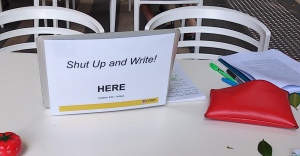 |
| Søren Kierkegaard's thesis (Wikipedia) |
We’ve all heard good teachers and orators lay out what they’re going to cover in their talk.
It usually happens early on, and when done well, it is unobtrusive and incredibly useful to help us ‘get’ what it is they are going to talk about.
Depending on the situation, this bit of chatter, may remind listeners of what was covered previously (where they’re coming from), of the scope and nature of their current talk, and indicate how they’re going to proceed (where they’re going).
This bit of talk ensures everyone is ‘on the same page’ and acts as a launching pad from which things can proceed.
It gives us a moment to collect ourselves mentally and it reduces cognitive load because we don’t have to second-guess where things are heading.
As an audience member, I appreciate this early orientation because I want to know upfront how my time is going to be spent.
Linguists call this chatter ‘metadiscourse’ - that is, talk about the talk, or “discourse about discourse” (Feak and Swales 2009, p. 38). Generally this discourse is empty of content - although it may include a position or argument statement.
Metadiscourse features a lot in academic writing - and especially in thesis writing. Generally speaking, the longer the manuscript, the greater the amount of metadiscourse. Feak and Swales (2009) say that expository texts have more of it than narrative texts.
Metadiscourse is most commonly found at the beginning and end of chapters and as a segué between different parts within chapters. At its most basic, it aims to foreshadow what is to come and how, and perhaps also connect backwardly to what has been covered/ argued. Metadiscourse is a feature of a reader-friendly text (Paltridge & Starfield, 2007).
Not surprisingly, we can expect to find a fair bit of metadiscourse in the average dissertation or thesis, although some disciplines favour it more than others. Hyland (1998) describes variations across disciplines. In my own experience, I’ve seen a lot of it in economics and theses that are heavily argument driven, and less in the pure sciences and humanities.
Evans and Gruba (2002) outline a useful structure for the beginnings of chapters: that is the three moves of backward reflection to the previous chapter, to state what’s in the current chapter and to foreshadow what follows.
The rendition of these steps or ‘rhetorical moves’ will vary - for example they might appear as three distinct paragraphs, or be combined in one paragraph, or even as one sentence.
Here are some examples of sentence structures or ‘skeletons’, as Kamler and Thomson (2013) call them, that may be located at the beginnings or endings of chapters or between segments of a text.
Current orientation
The focus of this chapter is ….
This chapter reviews the literature on … , beginning with an overview of the key disciplinary influence s…
Backwards orientation
This chapter follows from a detailed report of the findings that …
The previous chapter provided an historical review of the evolution of these models. To recap, the main …
Future orientation
Having established the central argument, the next chapter ….
… and thus, the next chapter explores the key themes …
Combination orientations
This chapter analyses the environmental drivers first identified in Chapter 4. It begins by …, and then …., thereby establishing the context for a more thorough discussion in Chapter 7.
Following from the discussion of key findings in Chapter 5, this chapter lays the ground for the resultant recommendations presented in the final chapter.
Isn’t metadiscourse just plain boring?
Some readers object to this kind of directional voice, finding it intrusive and simplistic, even insulting. Certainly if it is formulaic and repetitive, reoccurring at regular intervals when it simply isn’t necessary, it can become tedious.
Using metadiscourse as a writing tool
As a writer myself, and as a writing teacher, I make frequent use of metadiscourse as a writing tool. My early drafts often have lots of metadiscourse signalling for me what it is (I think!) I’m doing. Later, I remove most of this writing.
When working with others, I often ask them to include explicit metadiscursive text between new sections of writing because this forces writers to clearly articulate their intentions for any particular section - and how these relate to what has come before, and what will follow.
Sometimes, together, we read only the metadiscourse or sentence skeletons to gauge the logic and rhetorical integrity of the writing. Removing the ‘content’ in this way, can reveal the strength of the structure as articulated in this “discourse about the discourse”.
________
A final note: There are some excellent resources on thesis writing from the fields of applied linguistics and ESL written for those who have English as a second language.
Supervisors are not always aware of these resources and of their applicability for all kinds of writers - irrespective of language backgrounds. After all, isn’t academic English just another foreign language??!!
Does any one have a favourite resource they wish to alert us to?
References:
Evans, D. & Gruba, P. (2002). How to write a better thesis (2nd ed.). Carlton: Melbourne University Press.
Feak, Christine B., & Swales, J. M. (2009). Telling a research story: writing the literature review (Vol. 2 of the revised and expanded edition of English in Today’s Research World). USA: University of Michigan Press.
Hyland, K. (1998). Persuasion and context: the pragmatics of academic metadiscourse. Journal of pragmatics, 30(4), 437-455.
Paltridge, B. & Starfield, S. (2007). Thesis and dissertation writing in a second language: A handbook for supervisors. Oxon: Routledge.
Thomson, P., & Kamler, B. (2013). Writing for peer-reviewed journals: strategies for getting published. Oxon: Routledge.










